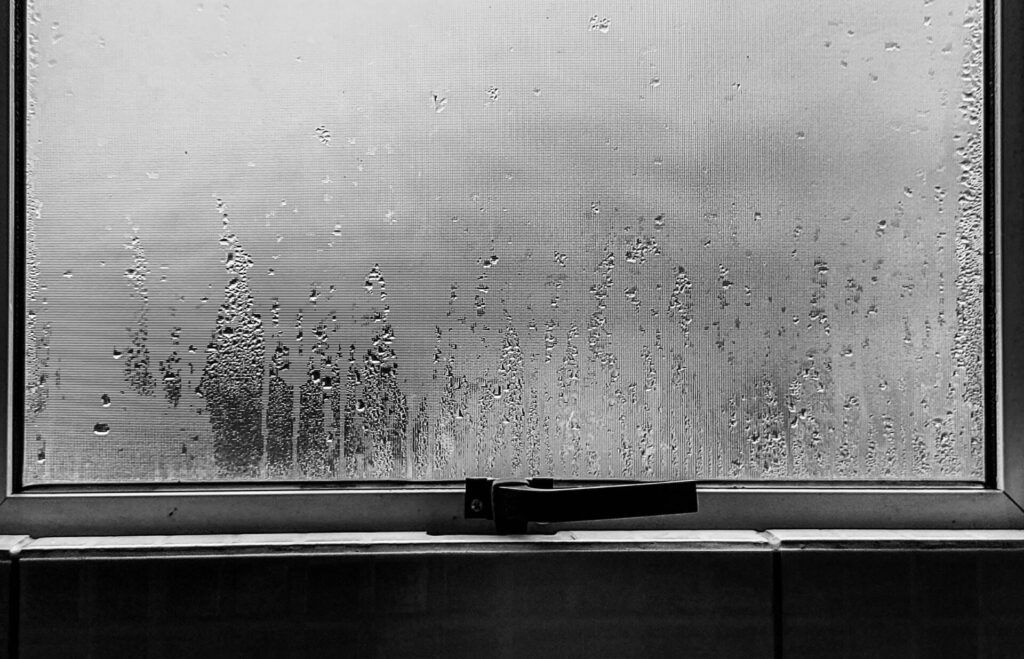There’s nothing worse than feeling a cold draught coming from your windows when you’re trying to get cosy on your sofa.
Not only does it cause you discomfort, it also leads to higher energy bills due to heat loss. And at a time when energy bills are more costly than ever, draughty windows are not ideal.
Draughts can be caused by damaged or faulty windows and will eventually need professional repair.
However, the good news is that there are steps you can take to draught-proof your windows, without spending too much money in the first instance.

How do you spot a draughty window?
-
Look for visible signs of window damage
- If you suspect your windows are letting in cold air, the first thing to do is check for any visible damage. Can you see any cracked window seals or gaps in the frame? Is there condensation forming between the glass panes?
-
Do the candle test
- Before you go lighting candles, make sure you move any flammable materials (like curtains!) out of harm’s way. Light your candle and then move it around the window frame. Does the flame flicker? You’ve found your window draught.
-
Run your hand along the window edge
- You can spot draughty windows by running your hand alongside the window edge. If you can feel cold air coming in, you’ve confirmed the problem.

Draught proofing windows: DIY tips & affordable fixes
Use self-adhesive draught excluder strips
Have you spotted small gaps around your window frames? A cost-effective way to prevent cold air from entering your home is by using draught excluder strips.
Draught excluder strips can be used to seal small gaps around your window frames by creating a tight seal.
They are relatively easy to install and can reduce heat loss without the need for specialist tools or expertise.
Different types of draught excluder strips
The right type of draught excluder strip will depend on the size of the gap and the material of your window:
| Type of draught excluder strip | Benefits | Cons |
| Foam Strips | Ideal for small to medium gaps (1–5mm). | Foam degrades over time, especially in humid conditions, making it less durable. |
| Rubber (EPDM) Strips | Soft, compressible and easy to apply. | Slightly more expensive than foam, but lasts longer. |
| Brush Strips (Pile Weatherstripping) | Suited to wooden or older window frames where slight warping may have happened. | Not suitable for sealing completely static gaps, as it doesn’t provide an airtight seal. |
Use window sealant to close gaps
Can you see small cracks or gaps around your window frame? Over time, small cracks can form where the window frame meets the wall, which lets cold air in – this is particularly common in older wooden window frames.
You may be able to seal the gaps around your window frames with high-quality window sealant. This can block draughts, prevent heat loss and also reduce moisture penetration to stop damp and rot.
Best overall choice: Silicone sealant
There are a variety of sealants available, but silicone sealant is the most versatile.
- It’s highly flexible – expands and contracts with window movement.
- It’s waterproof and weather-resistant – ideal for indoor and outdoor use.
- It’s long-lasting – lasts up to 20 years if applied correctly.
- Clear or coloured options – blends in with your window frames.
Where to apply window sealant



If you notice large gaps or crumbling window frames, a sealant may not be enough – your windows may need professional repair or resealing.

Use insulating window film for secondary glazing
Secondary glazing is a cost-effective alternative to double glazing, and is designed to add an extra layer of insulation to existing single-glazed or draughty windows.
It creates an air gap between the existing window and the secondary panel, trapping heat and preventing cold air from entering.
There are different ways of achieving secondary glazing.
| Secondary glazing type | Description | Pros | Cons |
| Plastic film | Referred to as insulating window film. It’s a thin layer of polyester, combined with an adhesive layer. | Cheap, easy to install, ideal for renters. | Less durable and needs replacing every 5 years. |
| Magnetic or clip-on acrylic panels | Uses strong magnets or clips to attach an acrylic panel to the window frame. | More effective than plastic film, reusable. | Needs to be precisely measured to achieve a tight fit. |
| Fixed secondary glazing | A fixed acrylic or glass panel attached to the window with a frame or hinges. | It is relatively affordable. | More expensive, not easy to remove. |
While secondary glazing can help improve insulation, it’s not as effective as double glazing.
Thinking about upgrading your windows? Our guide on the benefits of double glazing explores how it can help long-term energy savings.
Invest in thermal curtains
You can reduce the draught from your windows without making any changes to the glass or the frames with thermal curtains.
Thermal curtains can be made from a variety of different materials such as cotton, polyester, and wool. However, what they all have in common is that they are thick and lined, helping to trap heat and keep cold air at bay.
Top Tip: Hang your thermal curtains closer to the window and make sure they fully cover the frame to make them as efficient as possible.
While thermal curtains go some way to regulate room temperature, they won’t solve the root cause of the cold draught from your windows.
Fix broken or worn window locks & handles
Are loose window locks or wonky handles causing draughty gaps in your window frame?
In some cases, tightening screws or replacing worn-out locking mechanisms is enough to tighten any broken seals and reduce cold air coming into your home.
- Loose or misaligned locks stop the window from sealing fully and leave small gaps where cold air can get in.
- Worn-out handles may not shut the window tightly enough, which reduces its efficiency in blocking out draughts.
- Damaged locking mechanisms can cause windows to shift slightly out of position, which impacts insulation.
Signs draught-proofing window hacks won’t see you through

If your windows still don’t close properly…
So, you’ve tightened screws, replaced locks and you can still feel a cold draught?
It may be time to call a professional. If your windows won’t close properly, even after DIY fixes, it could be down to misaligned hinges, or faulty locking mechanisms.
Not only is this bad news for energy efficiency, but it also poses a potential security risk.
If your window frame is rotting …
If your window frame is rotting, it’s a sign of serious moisture damage – and that needs urgent attention.
When water seeps into wooden window frames, the material begins to soften, weaken, and eventually decay.
Window frame rot puts the structural integrity of the window at risk and creates gaps where cold air can enter, which does nothing to help your energy bills.
If you can see cracks in the glass or condensation…
If you have cracks in your window glass or you can see condensation forming between double-glazed panes, draught-proofing hacks aren’t going to cut it.
Misted windows usually mean that the seal has failed, which allows moisture in and makes your home feel colder.
However, cracks or misting glass don’t mean you have to replace the entire window. An affordable alternative is to replace the failed double-glazing unit (and you can explore the cost-savings of window repairs in this guide).
Cloudy2Clear specialises in this type of repair, helping homeowners like you restore insulation, without the expense of a full window replacement. Learn more about our window repair service.
Get in touch
Seeking professional repairs can save money in the long run by preventing heat loss, lowering energy bills, and improving security.
Our customers can trust us to quickly diagnose and fix common window problems. So, if you’re losing heat through draughty windows, get in touch.
Our expert engineers can repair misted double glazing, fix faulty seals, and realign misaligned locks – saving you money on energy bills.
Call 0800 880 7012 today for a free, no-obligation consultation.
